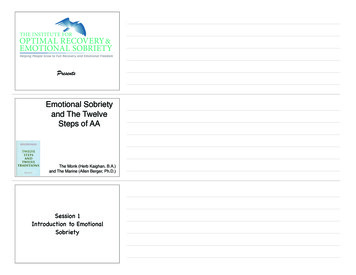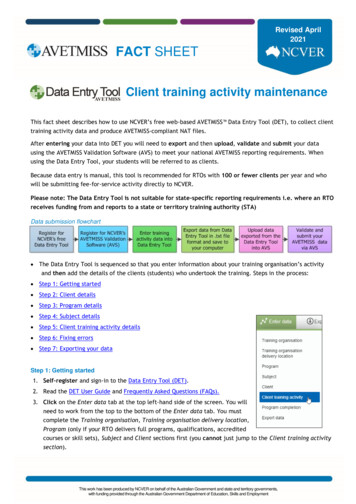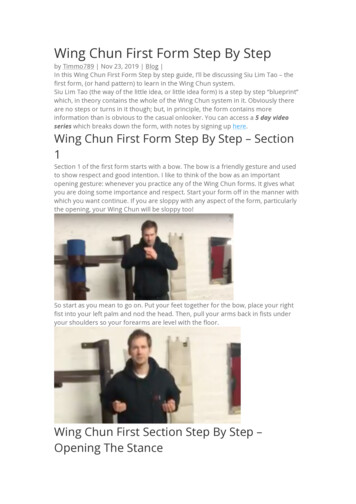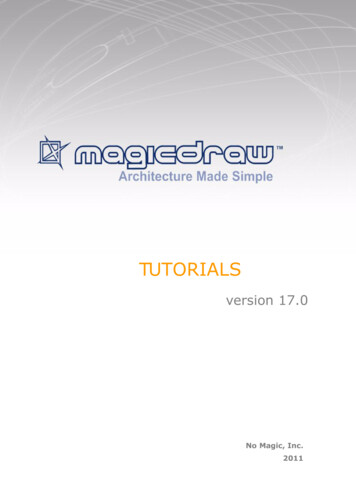
Transcription
The First Step in PreparingYour Students for Success.
Participants break up into groups within their program area: Example: Fitness, Group Fitness, Adventure, Intramurals, Sports Clubs etc. Group Discussion: What staff training assessment projects haveyou completed or currently in the process of completing?
Upon completion of the “Training Evolution” assessmentpresentation, participants will be able to Identify the Learning Assessment Cycle Create goals and objectives for individual programs Identify how to collect, analyze, and use data to modify supervisortrainings
Objectives DRIVE the assessment process Critical foundation to process Measurable, Manageable, Meaningful Objective #1 Example: The Student staff should know theEmployee Handbook. Objective #2 Example: Upon completion of the student staffemployee handbook training, they will be able to recite the fourpillars of service.
Discuss specific trainings that you would like to assess in yourspecific areas. Example: Adventure/Climbing Wall Training - Identify parts of a top ropeclimbing system to include top anchor, ATC, carabineer, and groundanchor. **BE SPECIFIC AND WRITE DOWN A LIST.
Select an appropriate design Design examples: Pre-Test, Post Test, Comprehensive Select an appropriate instrument Use pre-existing instruments Create your own Link instrument to assessment objectives Instrument Examples: Multiple choice (Identify), checklist (Reciteor Demonstrate)
Discuss designs and instruments that would correlate with yourobjectives. Example: Group Fitness – Developing a checklist for Group Fitnessinstructors to demonstrate the ability to adjust intensity by changing bodyposition, body angle, wide base, narrow base, single base. (TRXInstructors)
Who should we sample? Entering students? Graduating students? How often to collect data? Just once Annually Methods for data collection? Paper-and-Pencil Computer-based Web-based Sample size? Not too small, but not too large
Different Analytic Methods To Use Group Differences: Do we see expected differences inperformances by different student groups? Relationships: Do we see relationships between variables in theprogram? Growth: Do student performances change over time? Competency: Have program expectations been met?
How will information results be integrated between differentyears of program implementation? How will information be stored? How will information be retrieved?
**MOST IMPORTANT STEP: USE THE INFORMATION Planning and Budgeting Resource allocation Program Development and Student Learning Changing program methods Improving Assessment Revise the process for the future
Questions?
Goals and Objectives Examples
Upon completion of the Climbing Wall training, participants willbe able to Identify parts of a top rope climbing system to include top anchor, ATC,carabineer, and ground anchor. Describe all the safety checks for rock climbing as described in the JMUclimbing manual. Demonstrate proper AMGA standard for top rope belay technique 100% of the time. Demonstrates proper climber lower technique.
Upon completion of the Lifeguard Training, participants will beable to Demonstrate the skills deemed necessary, by the American Red Cross tocomplete the LGT certification. Demonstrate the skills needed to properly respond to a cardiac orbreathing emergency. Demonstrate the skills needed to properly respond to an injury to muscles,bones and joints.
Upon completion of the Fitness Instructor Training program,participants will be able to List the 5 components of Fitness and their definitions. Identify the major muscles of the body and their location with 100%accuracy. Identify and define the structure and function of muscle. Articulate the sliding filament theory. List the 3 types of muscle contraction.
Upon completion of the Free Weight Orientation, participantswill be able to Determine which UREC free weight/strength training equipment will bestsuit their workout needs. Demonstrate an understanding of specific exercises in relation to specificmuscle groups. Demonstrate correct exercise technique on UREC strength trainingequipment choices.
Upon completion of the Group Fitness Instruction Training,participants will be able to Identify correct locations of all major muscle groups. Demonstrate one exercise per piece of equipment per muscle group. Demonstrate proper alignment in poses and how to offer modifications forposes. (Mind-Body Instructors) Articulate the difference between Hip Hop, CDP, Zumba, and World beat.(Dance Instructors) Demonstrate the ability to adjust intensity by changing body position,body angle, wide base, narrow base, single base. (TRX Instructors)
Upon completion of the Site Manager Officials Evaluationtraining, Intramural Site Managers will be able to List three types of evaluation techniques to evaluate Sport Officials. Identify how to evaluate a Sport Official using the three evaluationtechniques. Identify the differences between how to evaluate a beginning andexperienced official by using three different areas of officiating. List four out of the seven keys to a successful evaluation.
Upon completion of the Information Recreation training,participants will be able to Learn the basics of each sport in “Pick Up and Play”, participate withother students/faculty, and meet one new person Identify task that need to be completed, such as, cleaning the RecAssistant closet, getting the count sheets ready, and creating fall schedules.
Upon completion of the Sport Club Common Training,participants will be able to Define the duties that various officers should be taking on and how todelegate them. Demonstrate the proper procedure for submitting all pertinent forms toUREC. Articulate the expectations for hosting an event at JMU/UREC.
Upon completion of the Climbing Wall training, participants will be able to Identify parts of a top rope climbing system to include top anchor, ATC, carabineer, and ground anchor. Describe all the safety checks for rock climbing as described in the JMU climbing manual.











